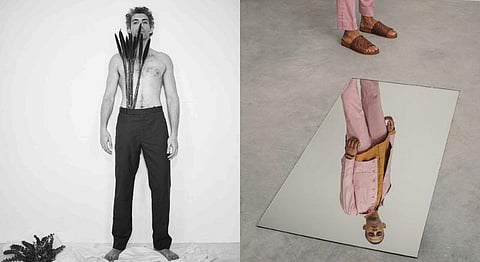
- #HGCREATORS
- #HGEXPLORE
- #HGVOICES
- #HGSHOP
- CAREERS
- ABOUT US
- CONTACT US

A scroll through Instagram or through the pages of many of our lifestyle magazines will have you feeling invigorated with the quality of visuals and the depth of context of the same. Indian photographers are creating campaigns filled with subtexts that go beyond the realms of materiality, aesthetics, and form. There is a bold depiction of culture in our lifestyle editorials and our photographers are not shying away from representing and dissecting the identity of the urban Indian.
Fashion lays the groundwork for innovation and creation and it is monumental in defining culture because it engages with a wider audience. The larger part of culture relies heavily on young and fresh voices to configure the mechanisms of thought and action and at Homegrown, we celebrate these creators for their ability to recognize and express the intricacies of urban life. So, we curated a list of photographers that we believe have something unique to offer to the culture of fashion and representation.
Farhan Hussain’s images have the ability to capture the essence of fleeting moments. There is a stillness in the motion of his images that comes with an acute understanding of subject and technique. With a list of campaigns for editorials like Harper’s Bazaar, Vogue, Verve and brands like Gucci, Hussain’s contemporary work is at the core of India’s commercial fabric. His ability to adjust his lens and focus according to the subject matter helps him to seamlessly navigate both commercial and personal projects.

II. Sahil Behal
Sahil Behal is a Mumbai-based fashion and lifestyle photographer. After a few years of oscillating between commerce and art, he finally found photography to be his preferred medium of expression. Initially, Behal exercised his passion for photography in the form of black & white portraits before evolving into colour. He strikes a balance between minimal and maximal shoots in a film format which keeps his style current and fresh. The linearity in his format is juxtaposed with a wider diversity in subject and emotion. Like a blot of ink organically adds form to a thick cartridge, his work, whether monochromes or bright visuals, lets the subject adjust and eventually dictate the language of the frame.


III. Indra Joshi
Indra Joshi’s images are marked by unique experiments with light and shadow. While there is an excess of creators that have mastered the technique and understanding of space and volume, there are very few that have managed to imbibe character and presence in their frames. Indra’s unorthodox frames and angles add a sense of personality to his work and this individuality separates him from others of his kind. He captures the essence of the mundane and removes meaning and context from subjects and spaces that dance gently outside the lines of expectation while operating within formal stages. True interpretation and fashion lie in capturing the unease in the subject matter and translating that unease into a balanced and comprehensible by-product. From Lakmé Fashion Week to Verve Magazine, Indra’s by-products have moulded themselves in the structure of urban fashion.

IV. Ritika Shah
Ritika Shah’s work shifts amidst themes with a high degree of comfort and depth. Her language is demarcated by her understanding of colour and frame rather than by homogeneity in technique. The colours flow and spill across her work as and when necessary and it is in this deliberate regulation that her intent shines. An alumna of the New York Film Academy, her introspective work is deeply rooted in a thorough understanding of narrative and film. This reflects in her fashion editorials as the words weave themselves into the texture of its site and context. Take her campaign for Raw Mango for example; the dualism between the women and the background in the frame allow the women enough mobility to communicate and express.

Anirudh Agarwal’s visual language is unique and bold. There is a wide range of influences that are evident in his work. His storytelling oscillates between fashion, lifestyle, contemporary and experimental photography. His projects ‘Ab Vovo’ and ‘Done’ stand testament to his brilliant technique. He marries imagery with experimentation and a distillation of the subject matter has lead to a unique by-product that does justice to the concept, subject, and setting. His work with Harper’s Bazaar and Nikhil Thampi, and even his personal exploration in the realm of photography testify his talents and range.

Feature image credits - (L) Sahil Behal & (R) Ritika Shah
If you liked this article, we suggest you read :
